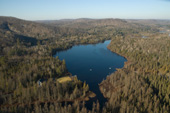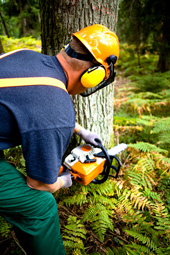Big forest deal in Canada: boost or blow to FSC?
The Canadian Boreal Forest Agreement (CBFA) is a truly big deal.
A forest area larger than the entire territories of Germany and Finland put together is now covered by a landmark agreement between two groups with very different agendas: the Canadian lumber industries and leading environmental organizations.
The agreement is signed between the Forest Products Association of Canada (FPAC) and nine NGOs, including major campaign organizations such as Canopy, Greenpeace and ForestEthics.
Boreal deal buries the hatchet
The agreement is a historic turning point in a long-standing and fierce debate on forestry practices in Canada. Now the two sides are burying the hatchet and entering into a new era of collaboration.  The agreement implies a win-win situation: The wood industries agree to adopt more sustainable forest management practices, thus fulfilling one of the NGOs’ core agendas.
The agreement implies a win-win situation: The wood industries agree to adopt more sustainable forest management practices, thus fulfilling one of the NGOs’ core agendas.
For the joining lumber industries, strong NGO backup could ensure leverage on a declining market.
Canadian pulp goes into much of the paper used in the US; and major US paper consumers such as Scholastic, Kimberley-Clark and Victoria’s Secret have shifted towards sustainable paper procurement policies in recent years, partly prompted by NGO campaigns.
The deal involves joint efforts to secure market recognition for forest products from the area, and the NGOs pledge to suspend campaigns targeting individual members of the FPAC and their clients. In a release, ForestEthics Executive Director Todd Paglia said: "ForestEthics' work with huge US corporate consumers of paper has, along with our allies, quite simply transformed the standards by which the American marketplace chooses its paper – and that is changing how forests are treated in North America. […]".
“World leading sustainable forest management practices”
A key element of the CBFA is the development of ambitious ecosystem-based management guidelines. The initiative’s official homepage states that the signatories are committed to “implement world-leading, on-the-ground sustainable forest management practices”. Independent third-party auditing will be implemented to verify compliance on the ground. It all sounds rather like the beginnings of a new certification scheme. However, this is not the case, says Melissa Filion of Greenpeace Canada: “We are working to raise the bar compared to existing schemes. However, the intent is by no means to come up with a different certification scheme”.
It all sounds rather like the beginnings of a new certification scheme. However, this is not the case, says Melissa Filion of Greenpeace Canada: “We are working to raise the bar compared to existing schemes. However, the intent is by no means to come up with a different certification scheme”.
In line with this approach there are no plans to develop a new product labeling system, she explains. Even so, the initiative is likely to affect the market position of the forest certification schemes that are operational in Canada – the FSC scheme and the PEFC- endorsed SFI and CSA schemes. Several of the signatory NGOs are known as FSC supporters. However, it is an open question whether the agreement will serve to support or undermine FSC in Canada.
FSC used as the reference point
According to available information, the agreement seems to be very focused on ecology, including nature conservation as well as a proactive approach to climate change. It looks as though the end result might be a green “star-quality” boreal forestry standard, while social issues could be left out of the guidelines or treated very superficially.
Melissa Filion does not share this concern. “The idea is to use the entire FSC Canadian boreal standard including all principles as a reference point, and then raise the bar from there”, she explains. “In addition, the best practices used by all three certification schemes will be integrated into the guidelines”. Filion explains that the NGOs see a need to improve on forest management practices on the ground in Canada, even for FSC certified operations. There is particular concern over the conservation status of Canada’s emblematic Caribou.
Filion explains that the NGOs see a need to improve on forest management practices on the ground in Canada, even for FSC certified operations. There is particular concern over the conservation status of Canada’s emblematic Caribou.
“FSC Canada has struck a science body to identify the gaps between the FSC standard and the need to protect critical caribou habitat,” she says. Within the 72 million hectares of Boreal covered under the agreement, about 29 million hectares of forest have been identified as Caribou habitat.
"Part of the logging and road-construction activities originally scheduled to take place until 31st of April 2012 have been deferred to areas outside the Caribou Range. And most importantly, the agreement involves a road map for science-based planning that targets Caribou conservation in the long term. As such it represents a vast potential for creating large new conservation areas for the species”, says Filion.
The area of scheduled logging and road construction that is moved outside of the Caribou range is 72,000 ha out of the originally scheduled 756,666 ha. Logging and road-building can still take place in the remaining 684,461 ha inside the FPAC caribou range during the next two years.
Good or bad news for FSC?
“Operations will want to benefit from the enhanced competitiveness and positive exposure that will result from strong NGO support”, says Alexandre Boursier, Regional Manager of the Rainforest Alliance in Canada. “That might lead to increased support for FSC. Since the FSC Canadian boreal standard will apparently form the backbone of the development of the CBFA management guidelines, operations following those guidelines should have a fairly easy time getting FSC-certified”.
But there are other possible scenarios, says Boursier: “Although less likely, it is possible that it could become more difficult for FSC to position itself on the marketplace. All operations under the agreement will be CBFA-blessed, and the NGO support could potentially satisfy some buyers". "This could be a problem for FSC, particularly if the final guidelines turn out to be less rigorous than the FSC standard in some respects - like First Nations’ rights, health and safety of forest workers or community involvement - while adding some green requirements.
"This could be a problem for FSC, particularly if the final guidelines turn out to be less rigorous than the FSC standard in some respects - like First Nations’ rights, health and safety of forest workers or community involvement - while adding some green requirements.
For some forest managers who are not already FSC certified, these measures and their recognition in the market could be sufficient and take away incentives to get FSC-certified. However, at the end of the day, I know the forest managers, mills, printers and other industrials who are currently having success with FSC will remain strong supporters of the standard and will maintain their market edge”.
The ink is still fresh on the paper and the future success and impact of the Canadian Boreal Forest Agreement clearly hinges on the details to be developed during the next years, and on its implementation in practice.
Boursier: “This is a significant and serious attempt to bridge the gap between the agendas of the forest industries and the environmental NGOs. It involves far-reaching collaboration including lobbying for government policies that support good management as well as the competitiveness of the Canadian forest industry. We can only wish the initiative good luck, and hope that it will serve FSC well, too”.
One thing seems certain: Whichever impact the Boreal Forest Agreement has on certification systems in Canada, this will have repercussions elsewhere and in particular in the US, which is a major importer of wood products from Canada.
Learn more about the initiative at www.canadianborealforestagreement.com/.
Source: Press releases and articles by Canadian Forest Products Assocation,
FSC Canada, ForestEtchics and The Dominion.